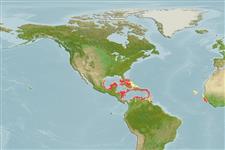Environment: milieu / climate zone / depth range / distribution range
Écologie
marin récifal; profondeur 20 - 300 m (Ref. 7321), usually 20 - 90 m (Ref. 7251). Tropical; 27°N - 18°S
Western Atlantic: southern Florida, USA and Bahamas to Venezuela; reported to reach Suriname (Ref. 13608) and Abrolhos Shelf (Ref. 126840). Eastern Central Atlantic: Gulf of Guinea. Reported from Cape Verde (Ref. 27000).
Taille / Poids / Âge
Maturity: Lm ? range ? - ? cm
Max length : 11.0 cm TL mâle / non sexé; (Ref. 9626)
Épines dorsales (Total): 7; Rayons mous dorsaux (Total): 9; Épines anales 2; Rayons mous anaux: 9
Adults prefer exposed deep reefs and rocky outcroppings (Ref. 7251). Eggs are incubated orally by both parents (Ref. 240). This is the only species in the genus Apogon with mouthbrooding done by males and females (Ref. 85456).
Life cycle and mating behavior
Maturité | Reproduction | Frai | Œufs | Fécondité | Larves
Biparental mouthbrooders (Ref. 240, 58875). Spawning may occur throughout the year (Ref. 39366). Distinct pairing during courtship and spawning (Ref. 205). This is the only species in the genus Apogon with mouthbrooding done by males and females (Ref. 85456).
Robins, C.R. and G.C. Ray, 1986. A field guide to Atlantic coast fishes of North America. Houghton Mifflin Company, Boston, U.S.A. 354 p. (Ref. 7251)
Statut dans la liste rouge de l'IUCN (Ref. 130435)
Menace pour l'homme
Harmless
Utilisations par l'homme
Plus d'informations
RéférencesAquacultureProfil d'aquacultureSouchesGénétiqueElectrophoresesHéritabilitéPathologiesTraitementNutrientsMass conversion
CollaborateursImagesStamps, Coins Misc.SonsCiguateraVitesseType de nageSurface branchialeOtolithesCerveauxVision
Outils
Articles particuliers
Télécharger en XML
Sources Internet
Estimates based on models
Preferred temperature (Ref.
123201): 22.4 - 28, mean 26.5 °C (based on 260 cells).
Phylogenetic diversity index (Ref.
82804): PD
50 = 1.0000 [Uniqueness, from 0.5 = low to 2.0 = high].
Bayesian length-weight: a=0.01122 (0.00528 - 0.02384), b=3.10 (2.92 - 3.28), in cm total length, based on LWR estimates for this (Sub)family-body shape (Ref.
93245).
Niveau trophique (Ref.
69278): 3.5 ±0.5 se; based on size and trophs of closest relatives
Résilience (Ref.
120179): Milieu, temps minimum de doublement de population : 1,4 à 4,4 années (Fec=1,900).
Fishing Vulnerability (Ref.
59153): Low vulnerability (10 of 100).
Nutrients (Ref.
124155): Calcium = 115 [68, 204] mg/100g; Iron = 0.963 [0.588, 1.541] mg/100g; Protein = 19 [18, 20] %; Omega3 = 0.211 [0.125, 0.347] g/100g; Selenium = 46.1 [23.8, 88.8] μg/100g; VitaminA = 82.8 [29.0, 233.9] μg/100g; Zinc = 1.74 [1.19, 2.46] mg/100g (wet weight);
